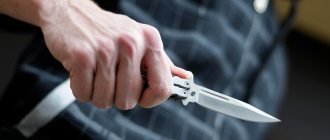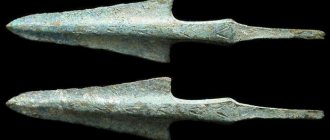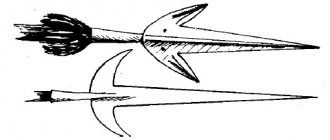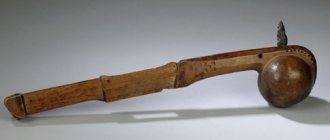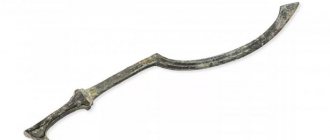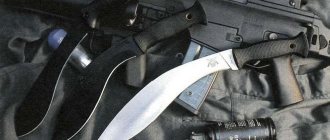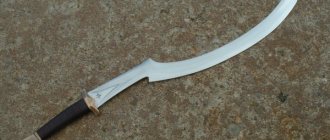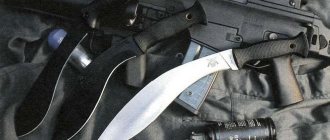Archaeologists are still finding prototypes of bladed weapons that served primitive people. Of course, they look primitive and far from the modern look, but in those distant times there was simply no other way. It was a means for hunting, butchering animal carcasses, and also for protection from attacks from other tribes and wild animals. Over time, it improved, and modern, familiar species appeared.
Before the development of firearms, cold was the main thing in defense, attack and simply helping a person. Now edged weapons serve as auxiliary weapons, complementing the capabilities of small arms. Also, edged weapons can serve as equipment for a military uniform and national costume, or can be a reward.
Russian edged weapons
As long as humanity has existed, so many cold weapons have existed. Each century is marked by a certain type of weapon, a club, a club, spears, daggers made of stone and bones. A huge breakthrough in the development of edged weapons occurred after the discovery of copper. Thanks to the hardness, ductility and lightness of the metal, swords arose that became necessary in hand-to-hand combat. And in a fight with a beast, a sword was not at all superfluous. The spears now have metal tips.
Over time, the bow gained wide popularity, and the mace and club began to lose their positions. Under the Roman Empire, the bow was replaced by a crossbow, but with the use of armor, chain mail, and helmets, it also lost its effectiveness in use. Therefore, the iron sword becomes the main weapon for some time.
The emergence of small arms reduced its main role, and the primacy passed to sabers, as an addition to small arms. The encyclopedia of edged weapons describes in detail its varieties, starting with primitive clubs and ending with modern types.
I would like to pay special attention to Russian edged weapons.
From ancient times until the 14th century, they armed princely warriors and people's militias. In Rus' they used not only swords, spears, saber blades, but various types of axes and striking weapons were widely used, such as:
- clubs;
- mints;
- six-feathers;
- pernachi;
- maces;
- flails.
The same Russian epics tell of heroes who were armed with heavy clubs. The work “The Tale of Igor’s Campaign” describes the battle, “how sabers rattled against helmets, and Haraluz spears cracked.”
In a battle with the Swedes in 1240 on the Neva River, the Novgorod warrior used only an ax. Also used were konchars, thin, sharp boot knives that easily penetrated chain mail. Over time, konchars were replaced by swords, and boot knives were replaced by daggers.
Even after centuries, interest in edged weapons has not been lost; they are still relevant today.
Each type of edged weapon has gone through its own historical path in development. It was modified in conjunction with combat techniques and the improvement of firearms.
Some weapons turned out to be more durable, others were no longer used. For example, spears of the prehistoric era were an ordinary pointed stick, then a stick with a stone tip, and later an iron one. They reached the beginning of the twentieth century in the form of pikes, which were used by the lancers and Cossacks. The swords with which the princely warriors were armed eventually became broadswords and were used by heavy cavalry in the 18th and 19th centuries.
The saber turned out to be durable. It began to appear in Russian cavalry in the 10th-12th centuries. Subsequently, the saber came to the forefront in armament and, although it took on the appearance of a saber, it is still in combat service. Devices that deliver blows in battle were eliminated from weapons in the 17th century. Russian edged weapons are considered:
- sword, broadsword, konchar, epee, rapier, saber, half-saber, checker, cleaver, dirk, knives, dagger - these are the so-called “white weapons”;
- spear, pike, spear, axe, reed, halberd, protazan, esponton - these are polearms;
- club, oslop, shestoper, pernach, mace, flail, axes, klevtsy - these are shock weapons.
Since almost all of them went out of use, they naturally turned into antique edged weapons.
Certificate for ax
It must be said that a serious seller or manufacturer most often has certificates for such products, but buyers are usually not interested in them. Naturally, the certificate, if it exists, is not included in every package with an axe, but you have every right to request it from the seller separately.
For example, the vast majority of combat-looking knives that can be found on the open market are certified as household, tourist, etc., since certification standards (and examination, for that matter) allow this.
Please note that the weapon that is the subject of this article (i.e., historical edged weapons) must also have a certificate confirming that it is exactly that. There is, however, a contradiction in the legislation on this issue.
The seller, in turn, can quote you articles that, on the contrary, allow him not to certify his product, and he will be right. But having a certificate or a copy of it in your hands is in your interests, keep this in mind when purchasing.
Products that are structurally similar to weapons must also be sold with certificates . Also keep this in mind when purchasing! Here the seller (if it is an organization) will hardly be able to “excuse himself”, because It's not about weapons anymore.
What is a bladed weapon and what is not?
The official definition of this type of weapon is given by legislation No. 150-FZ “On Weapons” dated December 13, 1996. However, some citizens, consciously or not, confuse household products with bladed weapons.
According to the law, a bladed weapon is a device that is designed to hit a target using human muscle power through direct contact with the target.
This includes:
- Knife, dagger, Finnish knife.
- Saber, dagger.
- Swords.
- Checkers.
- Swords.
- Brass knuckles.
- Stylet.
The standard characteristics of edged weapons are indicators that are defined in special documents:
- blade with a length of at least 90 mm;
- butt thickness 2.6...6 mm;
- blade with a hardness of more than 42 units according to the Rockwell method;
- safety handle;
- double-edged blade.
There are also throwable bladed weapons, but they should not be confused with a throwing device, which cannot be classified as a bladed weapon.
Throwable products are designed to hit the enemy at long, ultra-long distances and in hand-to-hand combat. The most common of them are:
- Onion.
- Crossbow.
- Sling.
- Chakra.
- Boomerang.
- Shureken.
- Dart.
- Tomahawk.
According to the definition of legislation, household appliances such as penknives, garden knives, and kitchen knives are not considered a type of bladed weapon, but they can also injure a person.
Manufacturing of edged bladed weapons to order: conditions and terms
Our Masters will make any type of bladed weapon especially for you and apply the necessary ornamental or runic symbols to the sheath or the blade itself. It is also possible to reconstruct rare thematic specimens for festivals or exhibitions. You can place an order and immediately discuss all the conditions for purchasing a reconstructed ancient weapon: a sword, dagger, checker, saber or knife, the timing of its forging, as well as other nuances right here and now. To do this, leave a request and answer the questions of the Master you have chosen to make edged weapons.
Remember: the strength of steel and blow, the power of the blade and the accuracy of even the best edged weapons are determined by the Spirit of the Warrior and his Courage, the Sincerity of love for the Native Land, his Ancestors and Descendants!
Show in full
Classification
Melee weapons have a variety of classifications, and there is no generally accepted order.
In common parlance, the definitions used by law enforcement agencies in their activities are more often used:
- as intended. Divided into combat and civilian. In the first version, these weapons are used in military, combat, operational and service operations by state paramilitary organizations. In the second version, it is used by some subjects for self-defense, hunting, and while playing sports. Serves as an addition to the national costume of some nationalities of the Russian Federation;
- manufacturing method. It can be produced in several ways: at a factory - the product meets technical requirements, standards, a marking is applied to the product, by handicraft method - made by gunsmiths in accordance with a certain standard, sample, the manufacturer can put his own brand, homemade - people without special professional skills are engaged in production or, they remake the weapon by adding elements to it or eliminating existing ones;
- by location of production. These weapons are produced by domestic and foreign manufacturers;
- according to the established standard. There are standard and non-standard products;
- by damaging effect. There are chopping bladed weapons, piercing-cutting, piercing, piercing-cutting, impact-crushing, throwing weapons, combined action;
- according to the features of the structural device. There are non-bladed and bladed melee weapons;
- according to the design features of the blade. Weapons come with one blade or two blades.
Scientific literature uses other classifications of edged weapons. For example, famous weapons experts E.L. Smolin, A.I. Ustinov, K.V. Asmolov, and the founder of Israeli hand-to-hand combat I. Lichtenfeld proposed their own classifications of edged weapons. Most likely, the creation of a unified classification in this area will be left to future generations.
Types of ancient edged weapons in the armory workshop catalog
In this section you can view, select and buy ancient bladed weapons of various types. We are pleased to present numerous categories under the names:
- Russian swords, made in accordance with all the rules of forging and hardening damask bladed weapons of the Slavs and more than once defeating the infidels and Khazars in raids on their native land, became the sacred symbol of Rus' and are depicted on numerous emblems and coats of arms.
- Cossack checkers and sabers are sharp, serving the atamans and the Slavic people, winning not one but hundreds of decisive battles and engagements and standing guard over the peace and order of the Russian Family.
- Daggers and knives for hand-to-hand combat and personal protection, carrying out the assignments given to them willingly and quickly, if necessary, remaining invisible to the opponent and always ahead of their actions.
- Also always available: samurai swords of the ancient Ainu and Scandinavian edged weapons, tournament swords and sabers, axes, coins, clubs, spears - everything you need to organize reenactment battles and hold an outdoor festival of any level, theme and scale. To such a large assortment of long-bladed weapons and military products of other varieties, we have added a category of ammunition and protection, where handmade armor, helmets, and shields are offered for sale. We plan to continue to fill our weapons workshop with high-quality and interesting goods for connoisseurs, hobbyists, or those wishing to make an original gift.
Difficulty of classification
A general definition has been given, but the classification of specific samples is a much more complex issue. And the reason for this is that the definitions in the law, as you can see, are formulated very broadly, and an ordinary stick can, if desired, be classified as a bladed weapon.
In general, it is known that the classification of weapons, especially historical ones, is a difficult and thankless task. But in legal matters you can’t do without it (although here it is even more confusing).
The fact is that different types of weapons have different legal regimes, and some products, which are quite dangerous in unreliable hands, as mentioned above, are not recognized as weapons at all.
Therefore, in order for classification issues for the purposes of law enforcement to be resolved more or less unambiguously, the legislator did the following.
He left the last word in this matter to “specially trained” experts who have a special, more or less identical, education. He also provided them with a huge amount of various documentation, on the basis of which they conduct examinations and certifications.
What if there is no certificate?
In this case, it will be more difficult to get rid of unnecessary questions and the product may even be sent for examination. And then everything is in the hands of an expert who will decide whether it is a weapon or not, and if so, which one, but more on that below.
A small clarification: there is a very thin line between certification and examination; to put it very simply, all this is the essence of a professional assessment of the characteristics of an object or model in accordance with the law. It’s just that certification is usually carried out for the further sale of a product/model, and examination is carried out in specific circumstances that require it (for example, for the purposes of an investigation, a trial, or simply for peace of mind).
